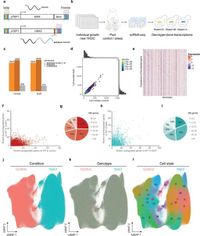A recent study led by researchers has unveiled a breakthrough in understanding how cellular makeup influences variability among genetically identical organisms, particularly in yeast. By constructing a comprehensive yeast knockout library, the team has developed a high-resolution single-cell transcriptome atlas that effectively represents the complex interplay between genetic mutations and individual cell responses to environmental stress. This groundbreaking research not only sheds light on the genetic underpinnings of cell state variability but also offers a valuable resource for future studies aimed at deciphering the relationship between genotype and phenotype.
The findings reveal that even among genetically identical yeast cells, significant transcriptional heterogeneity exists, which reflects the coordinated expression of distinct gene programs. The research identified 3500 yeast mutants and categorized their responses under both normal and stress conditions, thereby demonstrating how transcriptional responses can lead to a variety of cell states that are crucial for adaptation to changing environmental conditions.
“Transcriptional heterogeneity reflects the coordinated expression of specific gene programs, generating a continuous range of cell states that can be responsive to external insults,” stated the authors of the article. By leveraging intra-genetic variability, the research provides insights into how individual cells within a population can exhibit different behaviors, impacting their growth, stress response, and overall survival rates.
The innovative methodology employed by the researchers involved developing an RNA-barcoded genotype and clone deletion collection. This modification to the traditional yeast knockout collection (YKOC) allowed them to investigate the dynamic transcriptional behaviors of individual mutants on a genome scale. By performing single-cell RNA sequencing (scRNA-seq) across conditions, the scientists could characterize the relationship between mutant genotypes and their corresponding transcriptional profiles.
The research team devised a systematic approach to identify how genetic perturbations affect transcriptional heterogeneity, revealing that only a small proportion of mutants significantly altered the transcriptional landscape. Interestingly, while about 90% of mutants maintained cell state plasticity, mutations in mitochondrial function resulted in pronounced shifts toward specific cell states characterized by aging and impaired metabolic processes.
The study's results also establish that different cellular functions influence transcriptional heterogeneity. Specifically, negative regulators of transcriptional heterogeneity were found to encompass a range of cellular functions, including chromatin structure, transcriptional regulation, and mitochondrial activity. The researchers noted, “Mutants with decreased heterogeneity under control conditions showed significantly higher fitness upon stress than genotypes with high variability.” This suggests that maintaining a balance in transcriptional variation is crucial for cellular adaptability.
The implications of this study extend beyond yeast, with potential applications in understanding human diseases related to cell state plasticity, such as cancer and antibiotic resistance. By uncovering the genetic basis of transcriptional heterogeneity, the researchers provide a foundational resource for further investigations into how cells interact with their environment and adapt to stress.
As the team concludes, the Yeast single-cell Genotype-to-Transcriptome Atlas represents a significant milestone in genetic research, offering a platform for future studies that could lead to targeted interventions in health and disease.

